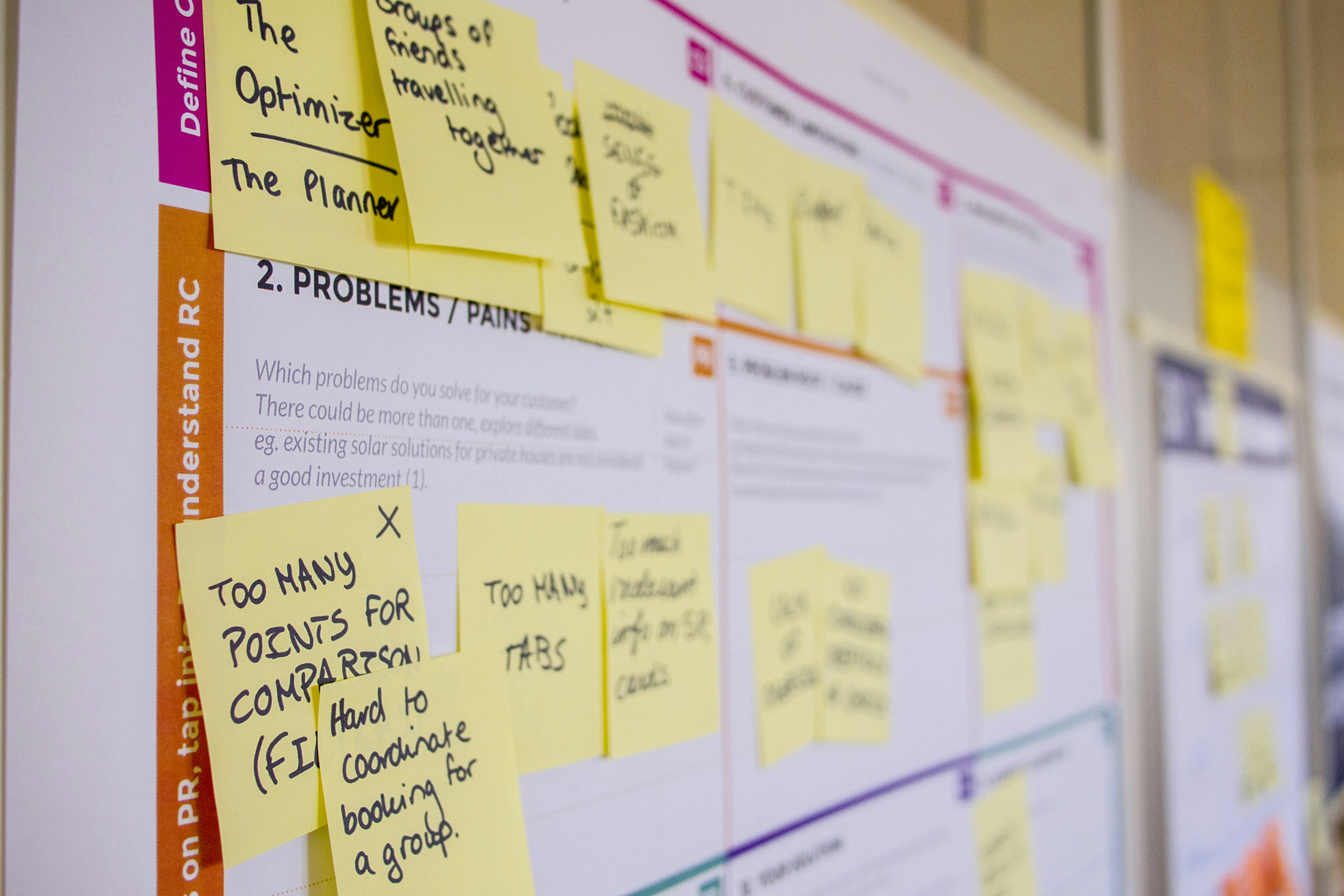How to Create a Technology Roadmap for Your Business

In today’s fast paced digital world, small and medium sized businesses face a big challenge: how to make smart technology decisions that drive growth without breaking the bank.
Companies across various industries use technology roadmaps as a strategic tool to guide their technology investments and innovation. The answer lies in creating a technology roadmap—a strategic plan that aligns your tech investments with your business goals.
But here’s the reality: 67% of small businesses struggle with technology planning, often making reactive decisions that cost them time, money, and competitive advantage. Some businesses try to do it alone, but many are finding the value of fractional CTO expertise to guide their technology strategy. A technology roadmap is a powerful tool to align technology with business strategy and ensure all teams are working towards the same objectives. This guide will show you how to create a technology roadmap that turns your business from tech reactive to tech strategic.
What is a Technology Roadmap and Why Do You Need One?
A technology roadmap is a strategic document that outlines how technology will support and advance your business objectives over time. Think of it as your GPS for navigating the complex world of business technology—showing you where you are, where you want to go, and the best route to get there. The benefits of having a technology roadmap include better decision making, better resource allocation, and increased project success by ensuring all technology initiatives are aligned to your goals.
Without a roadmap, businesses typically:
-
Make expensive technology purchases that don’t integrate well
-
Miss opportunities to automate and reduce costs
-
Fall behind competitors who use technology more strategically
-
Waste resources on redundant or incompatible systems
-
Struggle to align technology initiatives across the company with overall business strategy
Step 1: Assess Your Current Technology Landscape
Before you chart your course, you need to know where you are today. Start by evaluating your company’s current technology infrastructure and capabilities; this is the foundation for effective roadmap development. This assessment should cover:
Infrastructure Audit
Document all your current technology assets, including:
-
Hardware (computers, servers, networking equipment)
-
Software applications and licenses
-
Cloud services and subscriptions
-
Security tools and protocols
-
Data storage and backup systems
Note: In manufacturing environments, infrastructure audits are especially important as technology assets directly impact production processes and overall efficiency.
Performance Evaluation
-
What’s working well and what’s not
-
Where do you experience bottlenecks or inefficiencies?
-
What technology gaps are holding you back?
-
How satisfied are your employees with current tools?
-
How would you rate the quality of your existing technology systems and how does this impact overall business performance?
Cost Analysis
Calculate your total cost of technology ownership:
-
Monthly software subscriptions
-
Hardware maintenance and replacement costs
-
IT support and management expenses
-
Hidden costs from inefficient processes
This step often reveals surprises. Many businesses find they’re paying for duplicate software or that outdated systems are costing more in lost productivity than replacement would cost. Eliminating these redundant systems can save time and money.
Pro Tip: This assessment phase is where many businesses benefit from an experienced fractional CTO’s perspective. What seems like a simple inventory often uncovers complex interdependencies and hidden costs that require strategic expertise to evaluate properly.
Step 2: Define Your Business Goals and Technology Needs
Your technology roadmap must be driven by business objectives, not the latest tech trends. It’s important your technology roadmap aligns with your overall business plan so technology investments support your strategic direction and long-term growth.
Start by defining:
-
Your short-term goals (e.g., improve efficiency, reduce costs, attract new clients)
-
Your long-term vision (e.g., scale operations, enter new markets)
Short-term Goals (6-12 months)
-
Revenue targets and growth plans
-
Operational efficiency improvements
-
Customer experience enhancements
-
Compliance requirements
-
Marketing initiatives and strategies
Medium-term Goals (1-3 years)
-
Market expansion plans
-
New product or service launches
-
Launch new initiatives to drive growth or innovation
-
Scalability requirements
-
Competitive positioning
Long-term Vision (3-5 years)
-
Industry disruption preparedness
-
Innovation opportunities
-
Strategic partnerships
-
Exit or expansion strategies
-
Stay ahead of technological advancements
For each goal, identify the technology capabilities needed to achieve it. This links your tech investments to business outcomes.
The Strategic Challenge: While this seems straightforward, many business leaders struggle to translate business goals into specific technology requirements. This is where fractional CTO services add huge value—bridging the gap between business strategy and technology implementation with expertise most small businesses don’t have in-house.
Step 3: Evaluate Technology Alternatives
Evaluating technology alternatives is a key part of the technology roadmapping process. For small business owners, this can feel overwhelming with limited resources and so many options. But by following a structured process, many small business owners can confidently evaluate their options and choose technologies that support their business goals. This ensures your technology investments are aligned to your company’s objectives and you make the most of your resources and avoid costly mistakes.
Potential Solutions
The first step in evaluating technology alternatives is to identify a range of potential solutions that can meet your business needs. This involves researching the latest in your industry, reading case studies, and seeking recommendations from trusted sources. Small Business Administration resources such as the Small Business Administration website have valuable guidance and up-to-date information on technology trends and best practices for small businesses. Attending industry conferences, networking with peers, and consulting with technology experts can also help you find new solutions you may not have considered.
Many small businesses find technical roadmaps helpful during this stage. Technical roadmaps provide a visual view of the technology landscape making it easier to spot gaps, overlaps, and opportunities for improvement. By using these roadmaps you can compare technology alternatives and identify those that offer the most benefit.
Evaluation Criteria
Once you have a list of potential technology alternatives, the next step is to define your evaluation criteria. This ensures your decision-making process is objective and focused on what matters most to your business. Common criteria include cost, scalability, security, ease of integration with existing systems, and vendor support. For example, a small business might prioritize cost-effective solutions that can be implemented quickly without disrupting daily operations.
Technology roadmapping is especially useful at this stage as it helps companies identify what’s critical to their success. By mapping out your business requirements and aligning them to your technology options, you can evaluate each alternative against your specific needs. This structured approach allows you to compare solutions side by side and make informed decisions based on your company’s unique context.
Informed Selection
Now you’ve evaluated your technology alternatives against your criteria, it’s time to make a selection. This involves analyzing the pros and cons of each option and which one aligns best with your strategic plan. Many businesses find it useful to create a product roadmap at this stage outlining the development and implementation timeline for the chosen technology. A well-crafted product roadmap ensures everyone is on the same page and the implementation process supports your long-term business objectives.
Also, incorporating technology planning and technological forecasting into your decision-making process can help you anticipate future challenges and opportunities. By considering not only your current needs but also your company’s growth trajectory, you can select technologies that will continue to support your business as it grows. This forward-thinking approach allows many businesses to stay ahead of the curve and make technology investments that drive sustainable growth and long-term success.
Step 4: Prioritise Technology Initiatives
Not all technology needs are equal. To get the most out of your roadmap, make sure it focuses on the most impactful initiatives. Use this framework to prioritise your initiatives:
High Impact, Low Effort (Quick Wins)
These should be your top priority:
-
Software integrations that eliminate manual data entry
-
Cloud migrations that reduce IT overhead
-
Automation tools for repetitive tasks
-
Security updates that protect critical assets
High Impact, High Effort (Strategic Projects)
Plan these for medium-term implementation:
-
Complete system overhauls or replacements
-
Custom software development projects
-
Major infrastructure upgrades
-
Digital transformation initiatives
For these high impact, high effort projects, you need to allocate resources effectively to ensure successful execution and manage potential risks.
Low Impact (Consider Carefully)
These may not be worth the investment:
-
"Nice to have" features without clear ROI
-
Bleeding edge technologies without a business case
-
Solutions that duplicate existing capabilities
Reality Check: Making these prioritisation decisions requires deep understanding of both technology capabilities and business impact. Many successful companies engage fractional CTO expertise specifically for this strategic prioritisation, avoiding costly mistakes that can set back growth by months or years.
Step 5: Create Timelines and Budgets
Turn your prioritised list into an action plan:
Project planning is key to creating effective timelines and budgets as it helps outline key milestones and initiatives needed to achieve your technological and business objectives. Start by estimating the time and resources required for each initiative. Assign responsibilities, set deadlines, and allocate budgets accordingly. This structured approach ensures your team stays on track and each step aligns with your overall strategy.
Phase 1: Foundation Building (Months 1-6)
Focus on critical infrastructure and security:
-
Address immediate security vulnerabilities
-
Implement essential integrations
-
Establish reliable backup and recovery systems
-
Create standardised workflows
Phase 2: Efficiency Gains (Months 6-18)
Build on your foundation with automation and optimisation:
-
Deploy workflow automation tools
-
Optimize data collection and reporting
Phase 3: Strategic Advantage (Months 18-36)
Invest in technologies that differentiate your business:
-
Advanced analytics and business intelligence
-
AI and machine learning capabilities
-
Innovation platforms and tools
-
Strategic integrations with partners
By adopting these advanced technologies you can stay competitive in the technology industry and keep pace with industry leaders and technological advancements.
Budget Considerations
Plan for both obvious and hidden costs:
-
Software licensing and subscription fees
-
Hardware and infrastructure investments
-
Implementation and training expenses
-
Ongoing maintenance and support
-
Change management and employee training
-
Budgeting for additional resources to manage risks and support successful implementation
Financial Reality: Accurate technology budgeting requires experience with real-world implementation costs—not just vendor quotes. A fractional CTO brings this practical experience, helping you avoid the budget overruns that plague 73% of technology projects.
Step 6: Build Your Technology Stack Architecture
Design how your various technology components will work together:
The creation of a well-integrated technology stack is key to business success. By planning how each component interacts, you ensure seamless workflows and efficient operations.
Core Business Systems
-
Customer Relationship Management (CRM)
-
Enterprise Resource Planning (ERP) or business management software
-
Financial management and accounting systems
-
Project management and collaboration tools
Product managers often play a key role in choosing and overseeing these core business systems, ensuring technology roadmaps align with strategic goals and resource allocation for product development and business initiatives.
Supporting Infrastructure
-
Cloud computing platforms
-
Cybersecurity solutions
-
Data backup and recovery systems
-
Communication and collaboration tools
Integration Strategy
Ensure your systems can communicate effectively:
-
API connections between critical applications
-
Data synchronisation processes
-
Single sign-on (SSO) for user convenience
Centralised Reporting
Involve team members in key roles – such as roadmap managers, product developers, project managers, and industry experts – to ensure successful system integration and address the various technical challenges that will arise.
Integration Complexity: System integration is where many DIY technology roadmaps fall over. What looks simple on paper often involves complex technical challenges that require specialist expertise. That’s why many growing businesses find that fractional CTO guidance during the architecture planning phase saves time and prevents costly rework.
Step 7: Security and Compliance
Security isn’t an afterthought – it’s fundamental to your technology roadmap. Including security and compliance considerations early in the technology roadmap development process ensures your business meets industry standards and regulatory requirements from the get-go.
Essential Security
-
Multi-factor authentication across all systems
-
Regular security audits and vulnerability assessments
-
Employee cybersecurity training programs
-
Incident response and recovery plans
Compliance
Consider industry-specific regulations:
-
GDPR for businesses handling EU customer data
-
HIPAA for healthcare-related businesses
-
SOX for publicly traded companies
-
State and federal data protection laws
Risk Management
Build resilience into your technology strategy:
-
Regular data backups with tested recovery procedures
-
Redundant systems for critical business functions
-
Vendor risk assessment and diversification
-
Business continuity planning
Security Expertise Gap: Cybersecurity threats evolve daily and the cost of getting security wrong can be catastrophic. Many businesses find that the security expertise they need – but can’t justify hiring full-time – is exactly what a fractional CTO provides. The peace of mind alone is often worth the investment.
Step 8: Monitor, Measure, Adjust
A technology roadmap isn’t a set-it-and-forget-it document. Regular monitoring helps determine if your technology roadmap is delivering its intended outcomes. Establish processes for ongoing evaluation:
KPIs
Track the metrics that matter:
-
Return on investment (ROI) for technology initiatives
-
Productivity improvements and time savings
-
Customer satisfaction and experience metrics
-
System uptime and reliability measures
Regular Reviews
Schedule quarterly roadmap reviews to:
-
Review progress against timeline and budget
-
Assess changing business needs and priorities
-
Consider new technology opportunities
-
Adjust plans based on lessons learned
Continuous Improvement
Technology evolves quickly and so should your roadmap:
-
Stay up to date with emerging technologies in your industry
-
Gather feedback from employees and customers
-
Monitor competitor technology strategies
-
Plan for technology refresh cycles
Continuously developing your technology roadmap is key to staying ahead of the curve and remaining competitive.
Staying Current: The technology landscape changes so fast that what’s new today can be old tomorrow. Fractional CTOs stay current with technology trends as their full-time job, so your roadmap evolves with the market, not behind it.
Common Mistakes to Avoid
Learn from these frequent technology roadmap mistakes: Traditional assumptions about business and technology are often challenged by new technology trends and unexpected industry changes, so adaptability and open-mindedness are key.
Over-Engineering
Don’t choose complex solutions when simple will do. The best technology is often the simplest solution that meets your needs.
Ignoring Change Management
Technology success depends on user adoption. User interviews are valuable for gathering feedback and understanding user needs, which helps with user adoption during change management. Plan for training, communication, and support to get your team on board with new tools.
Focusing on Cost
While cost matters, the cheapest option often costs more in the long run. Consider total cost of ownership including implementation, training, and maintenance.
Lack of Executive Buy-in
Technology initiatives need leadership support to succeed. Ensure your roadmap has clear executive sponsorship and accountability. Organisation-wide support and alignment is key to successful technology initiatives and getting the roadmap implemented.
The Expertise Gap: Here’s what many business leaders find: creating an effective technology roadmap requires expertise they don’t have, but can’t justify hiring a full-time CTO. This gap between need and resources is exactly why the fractional CTO model has become so popular with growing businesses.
The Benefits of Expert Guidance
Creating an effective technology roadmap requires expertise across multiple domains: business strategy, technology architecture, security, compliance, and change management. Having the right knowledge and specialized knowledge in these areas is key to structuring a roadmap that aligns with your business goals and industry trends. Many businesses recognise that this level of expertise is exactly what they need – but not full-time.
This is where the fractional CTO model comes in. Rather than trying to develop this expertise internally or making expensive mistakes through trial and error, smart businesses are accessing enterprise-level strategic thinking without enterprise-level costs. Even a great idea for a new product or service needs expert execution, specialisation, and the right knowledge to succeed. A fractional CTO brings several key benefits to your technology roadmap development:
-
Strategic View: They’ve guided many businesses through similar technology decisions and can help you avoid common mistakes and spot opportunities you might miss.
-
Vendor Neutrality: Unlike consultants tied to specific technology vendors, fractional CTOs provide unbiased recommendations based on what’s best for your business.
-
Implementation Experience: They know the difference between what vendors promise and what works in real-world business environments.
-
Cost Savings: Their experience with technology pricing and negotiation often saves more than their fee in the first big purchase alone.
The best technology roadmaps aren’t created in isolation – they’re developed through collaboration between business leaders who understand the market and technology experts who have the specialism and knowledge to determine what’s possible and practical.
Ready to Build Your Technology Roadmap?
Creating a technology roadmap can feel overwhelming when you’re busy running and growing your business. You know technology is important to your success, but determining the right strategy and implementation approach requires expertise that most businesses don’t have in-house.
The companies that succeed with technology roadmaps have one thing in common: they know when to seek expert guidance rather than going it alone. Expert support is also invaluable when developing product roadmaps, which outline the planning and strategic direction for your specific products and are closely tied to your long-term business goals.
The Fractional CTO Advantage:
Instead of making expensive decisions in isolation or putting critical technology initiatives on hold, you can access experienced leadership that has guided hundreds of businesses through successful technology transformations. This isn’t just consulting – it’s strategic partnership with someone who has skin in the game for your success.
Ready to create a technology roadmap that delivers real business results? Our fractional CTO services help businesses like yours develop and execute strategic technology plans that drive growth, efficiency, and competitive advantage. We also provide expert guidance on product roadmaps to ensure your product development and release strategies are aligned to your business objectives.
Here’s what you get with our fractional CTO service:
-
Technology roadmap development based on your business goals
-
Product roadmap planning and strategic visualization for your products
-
Implementation oversight and risk management
-
Ongoing strategic guidance as your technology needs evolve
-
Access to enterprise-level expertise at a fraction of the cost
Book a free technology strategy call today and see how a technology roadmap – with fractional CTO guidance – can help your business. In 30 minutes we’ll help you spot your biggest technology opportunities and get clarity.
Don’t let technology hold you back. The best companies don’t go it alone – they partner with experts who can help them get there. Let’s get your roadmap started.









%20(1).jpg)